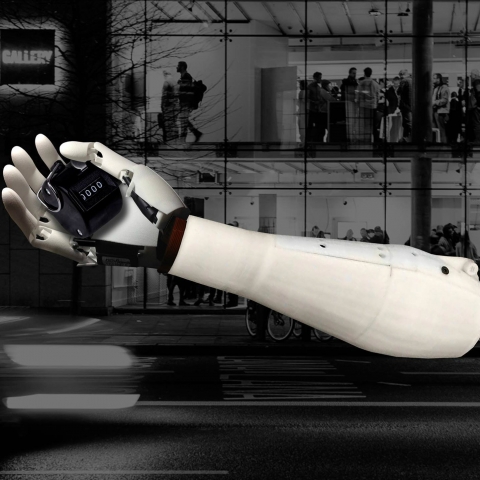
Last night, the Science Gallery launched their spring exhibition: Humans Need Not Apply. Following the successful run of their previous exhibit, Design and Violence, the gallery was teeming with visitors, with queues of people outside eagerly awaiting to see the displays within.
The title is somewhat misleading, evoking fears of a world where humans become obsolete as machines come to dominate daily life. However, the exhibition is not about presenting a dystopian future but instead focuses on the possibilities of artificial intelligence and explores the ways in which technology can have a major impact, both within the realm of the arts and in our daily lives. Overall, the installations focus on the ways in which technology can create culture, with algorithms attempting to mimic the human mind and body.
Upon entering the gallery a plethora of moving and interactive installations immediately draws you in, and one of the first to catch your eye is “The Mindfulness Machine”. Following the recent popularity of adult “mindfulness” colouring books, the machine, which looks like something straight out of Back to the Future, uses a robotic arm to colour in intricate mindfulness patterns. Watching the machine at work is strangely calming in itself, but the piece explores whether artificial intelligence can actually feel human emotion or if it can be programmed to demonstrate it in the same way. In fact, the machine makes artistic decisions based on a number of computer programmed variables such as tiredness and how many people are watching.
Next to “The Mindfulness Machine” lies a large white pen filled with “Antisocial Swarm Robots”. The small robots have sensors to detect their proximity to one another and if another robot comes into their “personal space” they immediately swerve to avoid it. Visitors are invited to interact with the machines, prompting them to move in different directions, and many visitors move to help the robots out of a rut when they became trapped in the corners of the pen. The project aims to explore the ways in which humans interact with robots and how we place emotions onto their supposedly emotionless, calculated actions.
Moving upstairs, there are more installations and artworks to explore, including a tickle machine, robots that copy your every move and a machine that is powered only by your energy. Particularly intriguing to me was “The Next Rembrandt”, a project that sought to revive the talent of the 17th-century Dutch master. A short documentary shows the process of using technology to generate the “average” features of a Rembrandt portrait, combining them to create an artwork through 3D printing. The final product is the result of a combination of both human and technological efforts. The painting itself is not advertised as an actual Rembrandt, but a new creation based on his work, an exploration in the possibilities of technology to teach us something new about an artist working over 300 years ago. As the original 3D painting was unavailable for this exhibition, the Science Gallery commissioned an artist to recreate it. This oil painting is described as a “portrait of a machine’s dream” and raises questions about authorship and authenticity.
Humans Need Not Apply displays important developments within the realm of technology and proves to be both an entertaining and insightful visit. The exhibition will be accompanied by a series of special events hosted by the Science Gallery including debates, behind the scenes and special guest speakers.
Humans Need Not Apply runs until May 14th, 2017. Admission is free.






